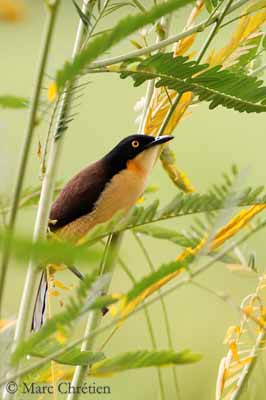
Black-capped Donacobius
Donacobius atricapillus
Passeriforme Order – Troglodytidae Family
BIOMETRICS:
Length: 22 cm
Weight: M: 53 g – F: 44 g
DESCRIPTION:
Usually, this bird is named only Donacobius. It is a marshland bird, displaying contrasting bright yellow and dark plumage, and long black and white fan-shaped tail.
This species is now considered as a Wren rather than Mockingbird. The breeding, vocal and courtship display behaviours are rather like Wren. Molecular studies (Barker – 2004) showed a potential relationship with the Old World species, such as White-eyes and Prinias. It could also be a New World representative of an Old World Family.

Donacobius has dark brown upperparts, and yellow buff underparts. Chin is paler than throat, and chest is becoming slightly darker on belly. Upper flanks are finely barred with transversal black bars.
Its name comes from a small white patch on upperwing. Long tail is dark, fan-shaped, with conspicuous white tips, becoming broader on outer feathers.
Forehead, crown, nape, cheeks and shoulders are black. A deep orange-yellow cheek pouch appears during courtship displays.
Eyes are bright yellow. Bill is blackish and slightly down curved. Legs and feet are black.
Both sexes are similar.
Juvenile has brown crown and nape. Body plumage is duller than adult and it lacks black barring on flanks. We can see a white supercilium behind eyes. It reaches the colours of the adults at the end of the first year.
There are geographical variations:
Donacobius atricapillus brachypterus, slightly smaller with paler plumage;
Donacobius atricapillus nigrodorsalis, darker above;
Donacobius atricapillus albovittatus, this one has a conspicuous white supercilium in adult plumage.
VOICE: SOUNDS BY XENO-CANTO
Donacobius pair utters fascinating duets. Both perch close to each other, one above the other, and often facing each other. They call while bobbing their heads and wagging their fanned tails jerkily. The upper bird utters a hard “chrrr” and the other a loud “kweea”. At this time, we can often see the orange-yellow pouches exposed.
This melodious duet lasts some seconds, and it is used for to keep away potential intruders. Male gives series of liquid whistles and female utters a lower grating sound. Male’s call varies in intensity from slow repetitions of whistles to rapid bursts of notes when it is very excited.
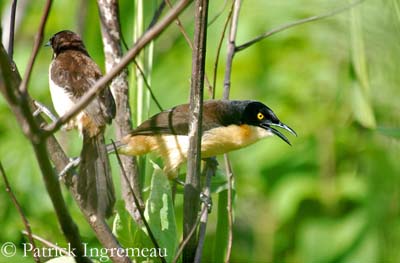
HABITAT:
Donacobius is resident along river edges with brushy areas and with invading dense vegetation in standing water. They need marshes for breeding. It can be found from sea level to 600 metres, and occasionally to 1400 metres in some parts of its range.
RANGE:
Donacobius is resident from eastern Panama to northern South America and in coastal area in Guyana. It is absent from the Pacific coasts.
BEHAVIOUR:
Donacobius feeds mainly on invertebrates. It gleans from leaf surface in grass, and may also catch flying insects, from low perches over water. It forages in vegetation and grassy marshes where it probes and plugs insects.
Donacobius is probably entirely resident in its range.
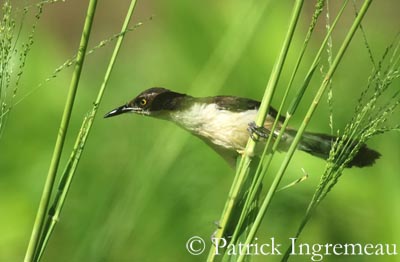
Pairs live in narrow territories along water edges. A large portion consists of marshy edges. Both display and sing duets at the boundaries.
Group members forage close to each other, within a few metres. But if other Donacobius from other group enter their area, or at territory boundaries, they strongly display and call against intruders. Territorial displays are frequent during one to two hours after dawn. Pairs are perched near a common boundary, and alternate duets against each other. We can hear a grating scold, uttered by either sex. It is an answer to the disturbance or at predator.
During the strong calling bouts, the orange-yellow throat pouches are inflated and puffed out laterally, and especially that of the male.
Family members may join the pair in these displays. These types of aggression or displays may occur when the groups meet in feeding areas.
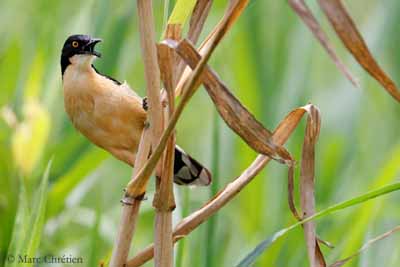
Courtship displays include a duet by both mates. They are on exposed perch, at about 2 to 4 metres above the water edge. Male and female are often perched side by side. Male begins with a series of liquid high-pitched whistles, and female follows uttering a lower grating sound. Both wag their fanned tails regularly from side to side.
Other intense display involves a hunched-back posture, with head and tail held down, and throat pouches completely inflated. We can also see sometimes the white spots of primaries when the bird opens its wings during the displays. Mates stay together all their life.
REPRODUCTION :
Donacobius’s nest is built in vegetation, reeds or grass, often over standing water, at about 25 cm to one metre above water. But nest may be built in other places, and when it is not over water, nest is located higher, up to two metres above the ground. Nest is mainly built by female.
It is a bulky open cup (external sizes 10 to 15 cm) with a nesting cup of 6cm depth and 8 cm in diameter. Nest is made with grass, plant fibres, and other materials frequently added, such as snake skins and silk from spider webs and cocoons. Donacobius may also take some materials from nests of other species. Breeding occurs during rainy months.
Female lays 2 purplish-white eggs, heavily spotted with reddish and purplish. Incubation lasts about 16 to 18 days, by female alone. Altricial chicks are naked at hatching. Adults wet them with their own soaked feathers, after immersion into the water.
Young are fed by both parents, but also by helpers which are offspring from the last breeding season, or for one or two seasons before. Young fledge when they are 17 to 18 days old.
When nesting care is shared by pair and helpers, broods are more productive. Helpers assist breeding pair in defence of the territory, feeding young and guarding the nest.
This species seems to produce one single brood and a second clutch of replacement if the first is lost. But sometimes, pair may produce two broods per year.
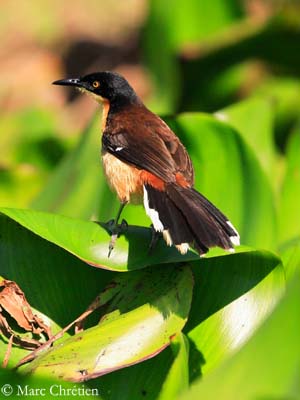
DIET :
Donacobius feeds mainly on invertebrates, insects and spiders.
PROTECTION/THREATS/ STATUS
Donacobius populations are common in suitable habitat. This species is widespread in its range in tropical South America, especially in Amazonia.
Eggs and chicks are preyed upon by snakes and birds.
Fr: Donacobe à miroir
All : Rohrspotter
Esp : Ratona de Capa Negra
Ital : Scricciolo mimo
Nd : Zwartkap-donacobius
Photographs by Marc Chrétien
His website : MURINUS
Photographs by Patrick Ingremeau
TAMANDUA
Text by Nicole Bouglouan
Sources:
HANDBOOK OF THE BIRDS OF THE WORLD vol 10 by Josep del Hoyo-Andrew Elliott-David Christie - Lynx Edicions - ISBN: 8487334725
Arthur Grosset's Birds (Arthur Grosset)
SORA Searchable Ornithological Research Archive (Blair O. Wolf)
CREAGUS@Monterey Bay (Don Roberson)